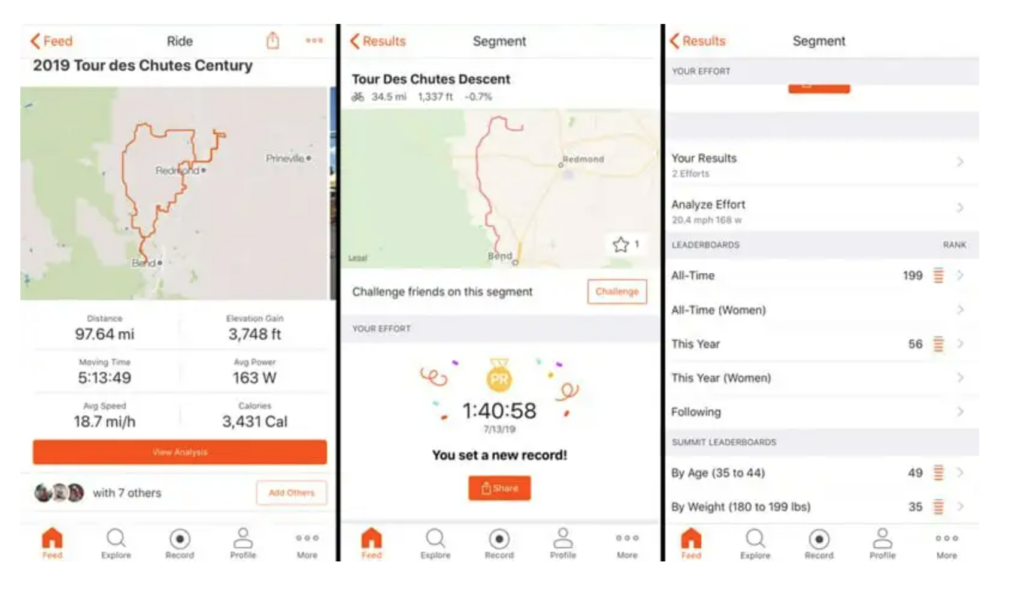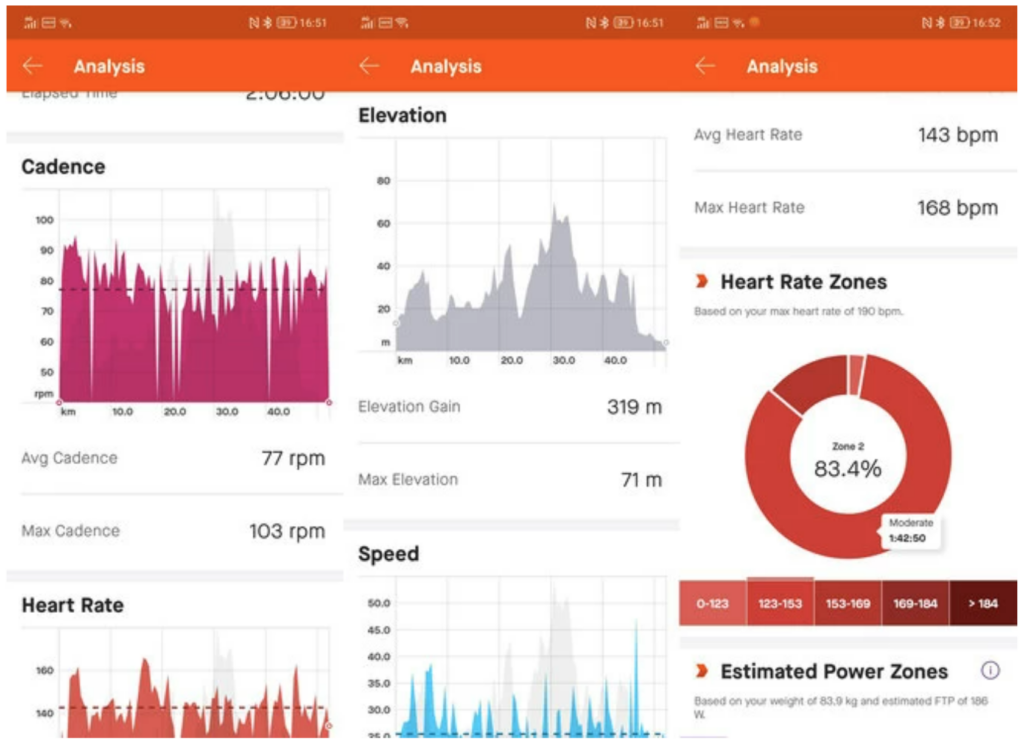STRAVA: COMPETE AGAINST THE WORLD

Strava is a social network for digital tracking of sports activities. Compare yourself with friends and world-class athletes and become a local sports celebrity.
WORKING OUT ALONE SUCKS
Strava was founded in 2009 and has since become the leading social network for internet-based tracking of sports activities. This summer the silicon valley startup hit a new milestone with 100 million registered users.1 However, the idea for a digital fitness platform emerged back in 1996.
When I was rowing on the college crew team it was my teammates that motivated and drove me to push my limits. When I left, I lost my team!
MICHAEL HORVATH – CO-FOUNDER OF STRAVA2
WHY DO I NEED ANOTHER DEVICE TO TRACK ME DOWN?
Good question. In a nutshell, the comparison with world-class athletes, the elimination of sports data multi-hosting and the motivation to be the local hero are really creating value. But convince yourself:
ACTIVITY FEED
This is the home screen of Strava, where users see posts detailing the sports activities of their network. The feed contains all functions known from a conventional social media platform. Sports activities can be recorded in Strava itself or synced from the users training devices be it an Apple Watch, Garmin, or other.3 Thus, users have all data stored in one place without having to tediously collect information from different platforms.3
ROUTES AND MAPS
Another value adding feature is the sophisticated mapping system. Users are able to create their own routes whereby they select the desired sport, length and topography of their next training. Three routes are then suggested along with details about distance, profile and estimated time. This is exceptionally valuable for frequently traveling customers. Users can even draw routes freehand and have them calculated automatically, which has led to amusing GPS arts in the past.3
SEGMENTS AND CHALLENGES
Segments are part of a longer route and let users compare their performance over a course with previous efforts and other (professional) athletes. Thus, its possible to examine a performance on a particular climb, downhill section or whatever to compete for King/Queen of the segment. These segment leaderboards are a key part of the app’s gamified user experience encouraging athletes to strive for more (or in my case too much). The drive to get your time on a segment as close to the world’s best as possible is indescribable. Particularly popular segments may even be converted into challenges. They can be sponsored with rewards, like a discount at a store for taking part in the challenge.3
TRAINING AND PERFORMANCE
Outside of mapping, recording and competing, Strava provides its users with sophisticated data analytics functions. The more athletes feed into the system, the more they receive. Strava aggregates the data into meaningful information about training and health. On a dashboard, users see how their fitness is evolving and how effective their training is.
SOUNDS CONVINCING, WILL I BE SWAMPED WITH ADS?
No, you won’t see a single advertisement! Strava uses a freemium model where customers can use a basic version for free but need to pay either a monthly (7.99$) or a yearly (60$) fee to access the bulk of its tracking and analytical tools. A membership elevates the Strava platform from a social network to a comprehensive training app. It gives users detailed heart rate and power analysis, training dashboards, and training diaries. Additionally, they can plan routes, set goals, and compare performances with friends and top athletes (for a detailed view about the paid features, check out this youtube video).4 Using this model to capture value, Strava successfully keeps entry barriers for prospects low and in return receives a high growht of its user base.
AND FINALLY, THE COMPANY FAILS AND ALL MY DATA IS GONE?!
Don’t worry, I think they are doing just fine! The platform facilitates a same side network effect meaning a change in value occurs with additional users. In recent years, the number of users has increased considerably with the platform having long since exceeded critical mass.
In the last two years, we’ve seen a tremendous shift in the importance of movement and sport in people’s lives!
MICHAEL HORVATH – CO-FOUNDER OF STRAVA5
Since Strava’s services are digitized, the costs of new users (CAC) are vanishingly small. Therefore, the current system is able to handle increased demand with little additional costs which makes Strava highly scalable. However, due to the entry of major competitors such as Nike or Adidas, the crucial user growth / base of Strava is endangered. I see this field as a winner takes it all market and Strava has positioned itself exceptionally well. The fact that most professional athletes use Strava (e.g. 70% of tour de France athletes upload stage results) makes this platform the most attractive for the crowd which is why I think Strava finds itself in a pretty sustainable position regarding their future.
SOURCES:
1Strava hits 100 million users as number doubles in two years – VeloNews.com
2 How Community & Gamification Made Strava A Billion Dollar Brand | Latana
3 What is Strava, how does it work and is it worth paying for? (pocket-lint.com)
5 Strava gives users’ experience a requested boost – VeloNews.com
6 Strava Art: Cyclists Get Creative — To Be Determined Journal Journal
8 Was ist Strava, wie funktioniert es und lohnt es sich zu bezahl (pocket-lint.com)
9 Strava Revenue and Usage Statistics (2022) – Business of Apps








I love Strava! Their ability to stitch together a bunch of different data sources is a huge selling point I feel. The points you made around scalability make total sense now that I think about it. It also seems to be to appeal to multiple types of users – casual people trying out fitness tracking, hardcore data driven device users, folks who are competitive, general fitness enthusiasts etc. Thanks for posting, I liked reading this!
Thanks Yannik! Though I don’t personally use Strava, I have a lot of friends who do and I have been shocked by how engaged the user base is. For this community, the freemium model is ideal. It makes the app completely accessible but given the level of commitment that many users demonstrate, there is a high potential revenue upside due to users purchasing access to additional tools. Given the recent push for people to have more active lifestyles, I think that this platform will continue to gain traction.
Thank you, Yannik, for the post! I haven’t used Strava but experienced the positive peer pressure to use one from many of their community members. What’s interesting is how they gamified it through a social network setup, unlike many other similar apps in their early days that took a self-monitoring perspective to sports and workouts. What’s also interesting from the graph is 2019 onwards, the growth in revenues grew at a much faster rate than its user growth which clearly points to increasing pricing; and despite that, the growth rate remained good. What would be interesting to see is the relative growth rates of its competitors, especially more recent ones, in terms of both revenues and user base, and compare their pricing strategies to see if some of their user personalities shifted out due to higher pricing. Thanks once again for the wonderful piece.